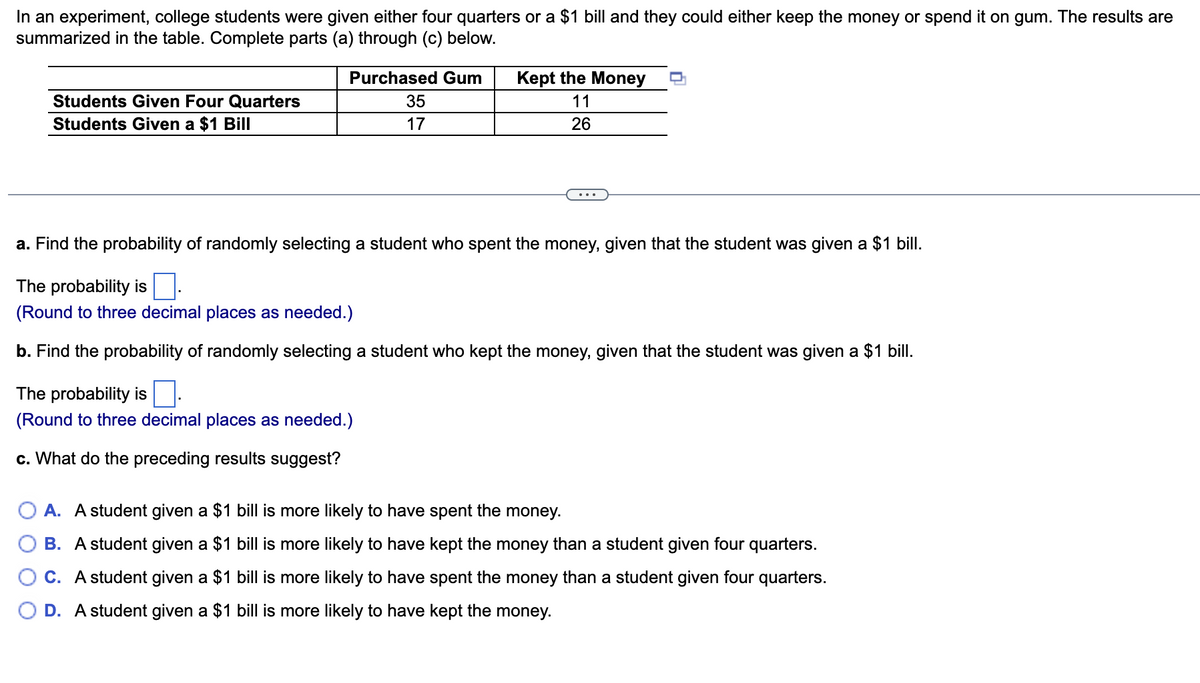In an experiment, college students were given either four quarters or a $1 bill and they could either keep the money or spend it on gum. The results are summarized in the table. Complete parts (a) through (c) below. Purchased Gum Kept the Money Students Given Four Quarters 35 11 Students Given a $1 Bill 17 26 a. Find the probability of randomly selecting a student who spent the money, given that the student was given a $1 bill. The probability is. (Round to three decimal places as needed.) b. Find the probability of randomly selecting a student who kept the money, given that the student was given a $1 bill. The probability is (Round to three decimal places as needed.) c. What do the preceding results suggest? O A. A student given a $1 bill is more likely to have spent the money. O B. A student given a $1 bill is more likely to have kept the money than a student given four quarters. O C. A student given a $1 bill is more likely to have spent the money than a student given four quarters. O D. A student given a $1 bill is more likely to have kept the money.
In an experiment, college students were given either four quarters or a $1 bill and they could either keep the money or spend it on gum. The results are summarized in the table. Complete parts (a) through (c) below. Purchased Gum Kept the Money Students Given Four Quarters 35 11 Students Given a $1 Bill 17 26 a. Find the probability of randomly selecting a student who spent the money, given that the student was given a $1 bill. The probability is. (Round to three decimal places as needed.) b. Find the probability of randomly selecting a student who kept the money, given that the student was given a $1 bill. The probability is (Round to three decimal places as needed.) c. What do the preceding results suggest? O A. A student given a $1 bill is more likely to have spent the money. O B. A student given a $1 bill is more likely to have kept the money than a student given four quarters. O C. A student given a $1 bill is more likely to have spent the money than a student given four quarters. O D. A student given a $1 bill is more likely to have kept the money.
Chapter8: Sequences, Series,and Probability
Section8.7: Probability
Problem 50E: Flexible Work Hours In a recent survey, people were asked whether they would prefer to work flexible...
Related questions
Question
19.

Transcribed Image Text:In an experiment, college students were given either four quarters or a $1 bill and they could either keep the money or spend it on gum. The results are
summarized in the table. Complete parts (a) through (c) below.
Purchased Gum
Kept the Money
Students Given Four Quarters
35
11
Students Given a $1 Bill
17
26
...
a. Find the probability of randomly selecting a student who spent the money, given that the student was given a $1 bill.
The probability is:
(Round to three decimal places as needed.)
b. Find the probability of randomly selecting a student who kept the money, given that the student was given a $1 bill.
The probability is
(Round to three decimal places as needed.)
c. What do the preceding results suggest?
O A. A student given a $1 bill is more likely to have spent the money.
B. A student given a $1 bill is more likely to have kept the money than a student given four quarters.
C. A student given a $1 bill is more likely to have spent the money than a student given four quarters.
O D. A student given a $1 bill is more likely to have kept the money.
Expert Solution
This question has been solved!
Explore an expertly crafted, step-by-step solution for a thorough understanding of key concepts.
This is a popular solution!
Trending now
This is a popular solution!
Step by step
Solved in 2 steps

Recommended textbooks for you

